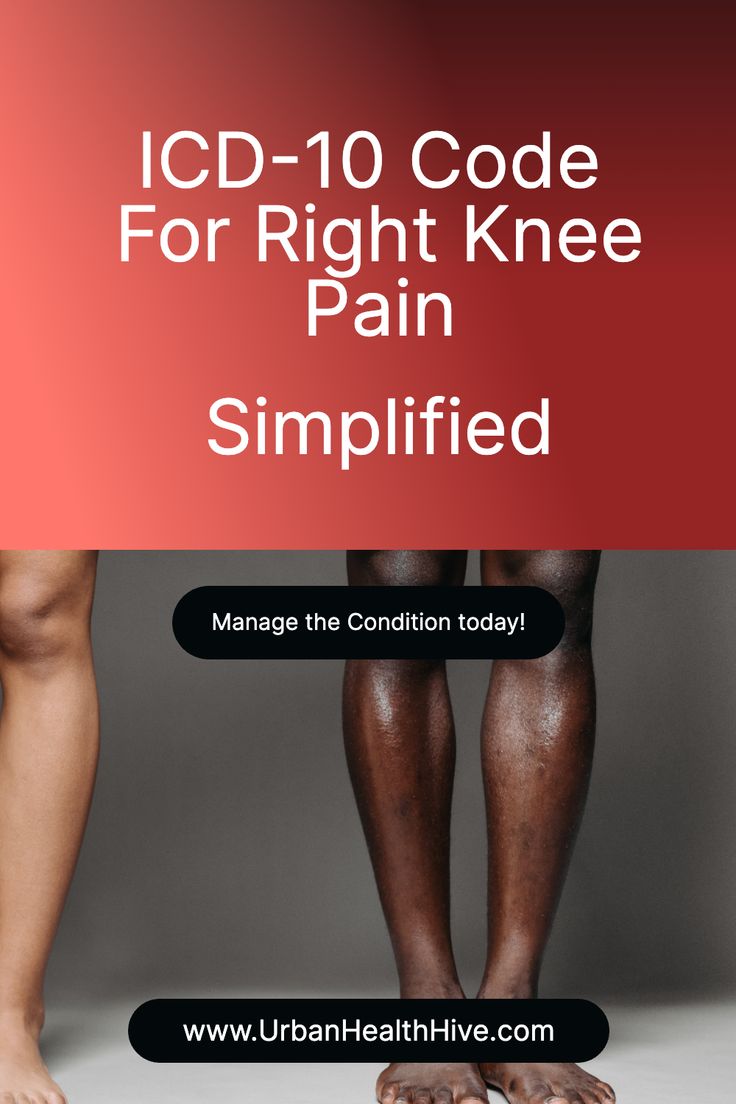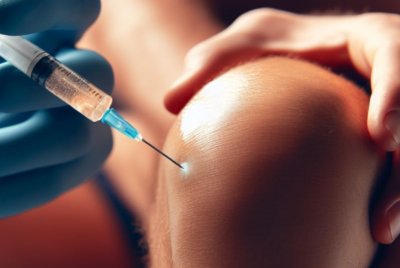ICD-10 Code For Right Knee Pain: Simplified
Navigating the world of medical codes can be as confusing as the pain itself. That’s where the ICD-10 code for right knee pain comes into play. Understanding this code is essential for proper diagnosis, treatment, and billing.
Before diving into the code itself, let’s explore some common causes of right knee pain. Whether it’s arthritis, a ligament injury, a meniscus tear, or just overuse, identifying the root cause is crucial.
As for the ICD-10 code itself, it’s M25.561. But here’s the thing – while this code encompasses a range of knee pain issues, it’s not a one-size-fits-all solution. It’s like trying to find the perfect shoe size; sometimes, you need that extra half size for the perfect fit. That’s why consulting a healthcare professional is vital. They’ll ensure you get the right code that accurately reflects your condition.
In the next sections, I’ll provide some suggestions and reviews based on my journey and research. Plus, we’ll discuss the effectiveness of different treatments because, believe me, not all remedies are created equal.
Making Sense of ICD-10 Codes
When you’re dealing with right knee pain, it’s essential to understand how these codes work. The ICD-10 code for right knee pain is like a code for a specific book in the library. It’s called M25.561, and it covers a broad range of knee pain conditions. But, here’s the catch – it might not perfectly fit your situation.
It’s like buying a pair of jeans off the rack. They might be close to your size, but they won’t fit like a tailored suit. That’s why it’s crucial to consult with a healthcare professional. They’re like the tailor who measures you precisely and ensures you get the right fit.
So, don’t get discouraged if the code seems a bit general. What matters most is that it guides your healthcare provider in understanding your condition and tailoring your treatment accordingly.
Causes of Right Knee Pain

So, what might be causing your right knee to act up? Well, there are several potential culprits:
1. Arthritis: Your knee joint can fall prey to arthritis, including osteoarthritis and rheumatoid arthritis. Osteoarthritis results from wear and tear on the knee’s cartilage, causing pain and stiffness. Rheumatoid arthritis, on the other hand, is an autoimmune condition where your immune system mistakenly targets the knee joint, leading to pain and swelling.
2. Ligament Injuries: Sudden twists or falls can damage the knee’s ligaments, causing significant discomfort. Ligaments are the tough bands that stabilize your knee joint.
3. Meniscus Tears: The meniscus, a crucial cartilage within your knee, can tear due to injuries or gradual wear and tear. Such tears result in pain, swelling, and potential joint locking.
4. Overuse: Sometimes, it’s a case of pushing your knee too hard. Activities like running can strain the knee joint due to excessive use.
Remedies for Right Knee Pain

1. Pain Management: Over-the-counter pain relievers can offer temporary relief from knee pain. Also consider wearing a knee brace or a knee strap for good support when required.
2. RICE Method: Rest, ice, compression, and elevation can help reduce pain and swelling in minor knee injuries.
3. Physical Therapy: Targeted exercises can strengthen the knee muscles and improve joint stability.
4. Weight Management: Maintaining a healthy weight can reduce stress on the knee joints, especially for those with arthritis.
Prevention Tips
1. Exercise Smart: Engage in low-impact activities to reduce the risk of knee injuries. Incorporate stretching and warm-up routines.
2. Proper Footwear: Ensure your shoes provide proper support and cushioning for your knees, especially during high-impact activities.
3. Balanced Diet: A diet rich in nutrients, including calcium and vitamin D, can support joint health.
4. Avoid Overexertion: Listen to your body and give your knees time to rest and recover between strenuous activities.
Treatment Options
1. Consult a Healthcare Professional: For accurate diagnosis and tailored treatment plans, consult a healthcare provider or orthopedic specialist.
2. Medications: Depending on the cause and severity of knee pain, prescription medications or injections may be recommended.
3. Physical Therapy: A physical therapist can guide you through exercises and techniques to improve knee function.
4. Surgery: In severe cases, surgical interventions like arthroscopy or knee replacement may be necessary.
Remember, the path to relief from right knee pain begins with understanding its causes, considering remedies, implementing preventive measures, and seeking the right treatment options tailored to your unique situation. Always consult a healthcare professional for personalized guidance.
My Recommendations for Right Knee Pain

Now, let’s talk about some practical suggestions and reviews based on my personal experience and research when it comes to dealing with right knee pain.
Seeking Professional Help
When you’re grappling with persistent right knee pain, the first and most crucial step is seeking professional medical help. Here’s why:
1. Accurate Diagnosis: Healthcare providers have the expertise to pinpoint the exact cause of your knee pain. It might be related to arthritis, a ligament injury, a meniscus tear, or another issue altogether. Accurate diagnosis is the foundation of effective treatment.
2. Tailored Treatment: Once they identify the root cause, they can design a customized treatment plan just for you. It’s like having a roadmap to recovery specifically tailored to your unique condition.
3. Pain Management: They can recommend pain relief strategies that go beyond over-the-counter medications, ensuring you find the most effective and sustainable way to manage your pain.
4. Long-term Well-being: Professional guidance ensures you’re not just addressing the symptoms but also focusing on your long-term knee health. It’s like investing in the future of your knee.
Physical Therapy: A Game Changer
One highly effective method for managing right knee pain is physical therapy. Here’s why it’s a game-changer:
1. Targeted Exercises: Physical therapists are experts in designing exercises that strengthen the muscles around your knee joint. These exercises help improve joint stability, reduce pain, and enhance mobility.
2. Pain Reduction: Through techniques like manual therapy, they can directly target painful areas, providing relief and promoting healing.
3. Personalized Plans: Physical therapy is not a one-size-fits-all solution. Therapists create personalized plans based on your specific condition and goals.
4. Education: You’ll learn about your condition, which is empowering. Understanding your knee pain allows you to actively participate in your recovery.
Remember, these are just recommendations based on my experience and research. Your healthcare provider is the ultimate authority to guide you through your journey to better knee health. Whether it’s seeking professional help or considering physical therapy, your knee deserves the best care possible.
Evaluating the Path to Relief

When it comes to dealing with right knee pain, it’s important to assess the effectiveness of various treatments and approaches. Ratings play a significant role in helping you make informed decisions.
Evaluating Treatment Effectiveness
1. Professional Help: When you consult a healthcare provider for your right knee pain, you can assess their effectiveness based on:
- Accuracy of Diagnosis: How well did they identify the cause of your knee pain?
- Treatment Plan: Did they create a tailored plan that addresses your specific condition and needs?
- Pain Management: Are their recommendations effectively managing your pain?
2. Physical Therapy: If you’re pursuing physical therapy, consider:
- Progress: Are you noticing improvements in your knee pain and mobility?
- Customization: Is the therapist adapting the treatment plan as needed?
- Education: Are you gaining a better understanding of your condition and how to manage it?
Patient Reviews:
Patient reviews can be invaluable in gauging the effectiveness of various treatments. Look for:
- Positive Outcomes:Reviews that highlight significant improvements in knee pain or mobility.
- Personal Experiences: Stories that resonate with your own situation can provide helpful insights.
- Long-term Results: Reviews from individuals who experienced lasting relief.
Professional Ratings
Consider the reputation and qualifications of healthcare providers and physical therapists. Look for board-certified professionals with positive patient feedback.
Remember, everyone’s experience with right knee pain is unique, so what works for one person might not be the best fit for another. Ratings and reviews can serve as valuable reference points, but always consult with a healthcare expert to determine the most suitable approach for your specific condition. Your journey to knee pain relief is a personal one, and informed decisions can lead to better outcomes.
My Takeaway on Right Knee Pain
As we near the end of this exploration into right knee pain, I want to leave you with some key takeaways and a sense of closure.
Dealing with right knee pain can be challenging, but it’s essential to remember that you’re not alone on this journey. Here are a few thoughts to ponder:
Seeking Help is Key: When it comes to persistent knee pain, don’t hesitate to reach out to a healthcare provider. They are your compass, helping you navigate through the pain to a better place.
Individuality Matters:Right knee pain isn’t a one-size-fits-all issue. It can stem from various causes, and what works for one person may not work for another. Embrace the uniqueness of your journey.
Knowledge is Power:Understanding your condition empowers you to make informed decisions about your health. Don’t be afraid to ask questions and seek clarity.
Recovery Takes Time:Patience is your ally. Healing and finding the right treatment can be a gradual process, but each step forward is a victory.
Professional Guidance: Trust the expertise of healthcare providers and physical therapists. They are your partners in recovery.
FAQ’s
1. Can I use the ICD-10 code for right knee pain without a doctor’s diagnosis?
While the ICD-10 code M25.561 exists for right knee pain, it’s best to consult with a healthcare professional for an accurate diagnosis. They can determine whether the code aligns with your specific condition.
2. Are there other codes for specific knee conditions?
Absolutely. The world of medical coding is vast, with numerous codes that cover different knee-related diagnoses. The specific code depends on your condition, so consult with a healthcare provider for precision.
3. How can I find a healthcare provider for my knee pain?
Start by reaching out to your primary care physician. They can provide referrals to specialists or orthopedic doctors who can assess your knee pain and recommend the most suitable treatment.
4. What are the treatment options for right knee pain?
Treatment options can vary based on the cause and severity of your knee pain. They may include physical therapy, medications, lifestyle adjustments, and, in some cases, surgical interventions. Your healthcare provider will tailor the treatment plan to your specific needs.
5. Is it important to regularly update the ICD-10 code for my knee pain?
Yes, it is. If your condition evolves or changes, updating the code ensures that it accurately reflects your diagnosis and treatment. Regular communication with your healthcare provider helps keep the code up-to-date.
Remember, these answers provide general guidance, but your unique situation may require a personalized approach. Consult with a healthcare professional to address your specific concerns and navigate your journey to relief from right knee pain effectively.
![Urban Health Hive]](https://urbanhealthhive.com/wp-content/uploads/2023/05/cropped-cropped-Health_Logo.png)



